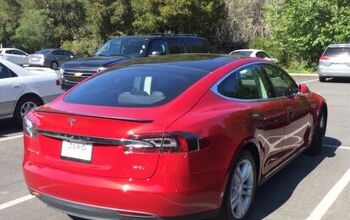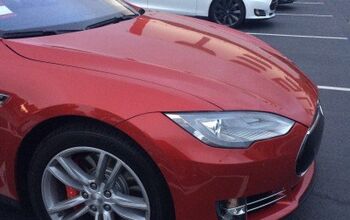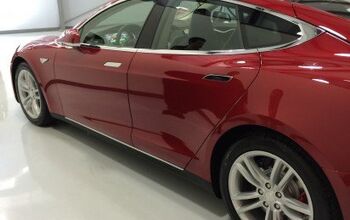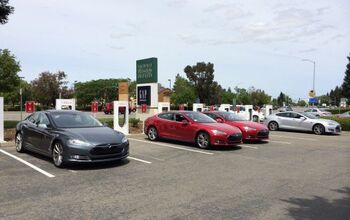TTAC Long-Term Tesla Part 3: (Super)Charging
Here’s a blunt statement for you: If you don’t have at least a 240V charger in your home, or plan on getting one very quickly, or live very near (10 minutes or less) to a Supercharger, do not buy a Model S. I hate to say that because I love this car. But charging without having a charger at home is frustrating and/or expensive.
I live in San Francisco and commute to Mountain View. For all the talk of this being the official car of the Bay Area Tech Douche, there are few convenient chargers available in the Palo Alto or Mountain View area. The nearest Supercharger is in Fremont, which is 30-40 minutes away – more if there’s traffic.
The Chargepoint network is an abomination. Finding a charger using their app (a hodgepodge of HTML mashing into Apple Maps) is ponderous. When you do find one, you had best hope it’s not a 120V charger. Because that will get you anywhere from 3 to 10 miles for each hour of charging, which is not useful when you drive 30 to 40 miles each way. This is also assuming one is *available* – many Chargepoint stations have two outlets, and you can’t reserve many of them.
You can also find chargers with SemaCharge, which is just as bad.
In San Francisco there are many chargers inside large, expensive garages, such as 3 Embarcadero. For $3.99 an hour for the first four hours, then $6 an hour afterwards, you can charge your car at a decent pace – I forget the exact rate, but I think I was at 50% and was quoted 5 hours to charge. So you’re paying for the garage, the charger, and whatever wacky rate they add on top of it.
Get your own charger if you want to save money on gas. Actually, get your own *240 Volt* charger. This will charge you at – I think – 20-30 miles for each hour of charging. This is bearable overnight, and will get you back on your feet for the next day. A 120V (as in a normal plug) will get you three miles an hour. That is not practical for any human being.
If you can, get the high-powered wall charger that Tesla sells. It can go from 40-80 miles for each charging hour, which will mean that you can just go to bed with your car charging. I got my building to install one, and if an apartment building can do it, you can do it.
Now, the positives. My Volvo cost about $50 a tank if memory serves, and that wasn’t even using premium gas (yes, I know miles per gallon is better, but I can’t remember). I’d say that I’d be gassing up on my current schedule two or three times a week. At a conservative estimate, that’s $400 a month. $4800 a year, $38,400 over the course of the 8 years of my warranty (yes, I bought an extended warranty). This is actually an underestimate deliberately engineered to ward off the potential comments of “you suck at math.” If I was filling up the Audi Q5 I drove via Zipcar, the cost of the premium gas they demand would be more like $80 a tank from about a quarter left. Yes, that’s an SUV, I know. But mathematically speaking the Tesla can and will save you money, and the additional stress of finding a gas station.
The “but what if I travel?” argument leads to the Superchargers, which I’ll talk about shortly. However, the general argument I can give you is that while the Chargepoint network sucks for the constant need to juice up, there generally seems to be – at least in California – a good network of places to charge. 4 star and 5 star hotels consistently seem to have 240V chargers – I spotted one in Charlotte, NC at the Ritz Carlton – and even some lower-end hotels in Napa appeared to have them. This isn’t to say that it isn’t inconvenient. The infrastructure of the overall EV-charging network needs significant work to establish the convenience of readily-available gas. However the argument of “you’re gonna get stranded” does not seem to apply in this state. Outside of California, it’s a different world, and I recognize that our state is in a unique situation.
Superchargers were originally advertised as beautiful little oases – places you could go, charge your car, get a cup of coffee, eat a bagel and relax. However, at least in Fremont, the result is less glitzy. A line of chargers, some metal chairs and a lot of buildings that you can’t go into. I was dreaming of being able to grab a cup of coffee and relax while the car juiced up. My dreams are shattered. Other Superchargers may be different – but you’d think the marquee Supercharger where you pick up your car would be gorgeous.
To quote the website: “Simply pull up and plug in, take a quick bathroom or food break, and get back on the road.” There was no usable bathroom at Fremont – at a late stop (10pm) I was able to use the intercom and security let me into the one in the delivery center. There was no food. I had to pathetically ask a secretary for a glass of water. Unless I intended to walk across a highway, there was no readily-accessible way to take a quick bathroom or food break unless I brought snacks and intended to pee on the ground.
When the Supercharger *works* it’s fantastic (and free). I really mean it. The ones that work can charge you with 200 miles worth of juice in just an hour – you can swing in, get your car powered up while you sit inside and then get out of there in 30 minutes to an hour. The new 6.0 firmware update allegedly will up the rate of charge at Superchargers to 400 miles an hour.
The problem for me personally is that Fremont is not convenient. Neither is Burlingame. I’m confused as to why there is no Palo Alto or Mountain View or San Francisco Supercharger.
There are also the issues of the deficient Superchargers. I’ve been to the Fremont charger three separate times. Chargers 1A and 1B charged my car at 180-200 miles per hour. However, 4B trundled along at 80-90, and took three tries to get it to even charge. I head similar complaints of other chargers doing the same from other people parked there, who were apparently not as big of an asshole as I am and thus just stayed at one point to charge. I did not call the Supercharger complaint line like it says to on the chargers. I would not be surprised if nobody ever has. I probably should have. But you’d think at the Tesla plant, where Tesla is, where Elon Musk (I assume) sits upon a throne of skulls, that the Supercharger would be flawless. It isn’t.
The Supercharger network is growing across the country, but there’s a fair amount of obfuscation as to where. You can’t zoom in on the list, you can’t click the red circles to find out where the exact spot is (and my geography sucks). The list doesn’t even update when you move to “coming soon.” There are fan-made listings that work based on permits, but there is no reason in the world that Tesla shouldn’t be providing this information themselves. Unless, of course, they’re worried that they’ll get railroaded if they reveal their plans.
From my research it appears that you could do a cross-country drive. I would be a little bit nervous to, or get the help of someone good at planning. By the end of 2014 it would appear that it’ll be a lot easier, and over time I can imagine the network will be good, even if you do have to settle for 80-90 miles per hour.
More by Ed Zitron
Latest Car Reviews
Read moreLatest Product Reviews
Read moreRecent Comments
- Zelgadis Elantra NLine in Lava Orange. I will never buy a dirty dishwater car again. I need color in my life.
- Slavuta CX5 hands down. Only trunk space, where RAV4 is better.
- Kwik_Shift_Pro4X Oof 😣 for Tesla.https://www.naturalnews.com/2024-05-03-nhtsa-probes-tesla-recall-over-autopilot-concerns.html
- Slavuta Autonomous cars can be used by terrorists.
- W Conrad I'm not afraid of them, but they aren't needed for everyone or everywhere. Long haul and highway driving sure, but in the city, nope.


































Comments
Join the conversation
Tesla invested in a dead technology. If Tesla wants EVs to take over the world, they should invest in inventing a "liquid battery", where discharged liquid can be pumped out and charged liquid pumped in. The rest is attempting to sugarcoat a problem. What if I want to drive in remote roads for 450km?
Interesting reading. A few months ago I thought long, and hard, about buying a Volt. For my daily driving needs, the Tesla, or even a Leaf would be perfect. I could get by without the I.C.E. engine. The Volt, however, caught my interest. I spread the total costs over 10 years. I'm 60 years old, and retired. We live on a comfortable, but fixed income. The numbers just didn't work for me. I picked up a 2014 4 cyl Impala. Nice car, but a little short on power. From what I read, the performance on the Tesla, is more than impressive. I do believe that the EV vehicle is here to stay. The Hybrid,however, seems to fit todays needs, for only certain demographics. For me, at my point in life?..No. BTW.. Saw a "Stop the Fracking Madness" bumper sticker on an old Four Runner, with blue smoke puffing out the tail pipe. I just shook my head.